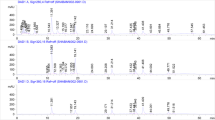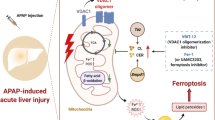Abstract
The mitochondrial damage has a pivotal role in triggering apoptosis and cell death. This study assessed the effect of silibinin on optical atrophy-1 (OPA1) and mitofusin-1 (MFN1) gene expression in liver tissue during hepatic warm ischemia–reperfusion (IR). Four groups of rats, eight rats each were designed: Vehicle: the rats received normal saline and encountered to laparotomy, Sili: silibinin (60 mg/kg) was administered to animals, IR: the rats received the normal saline and insulted by liver IR procedure, and IR + Sili: silibinin was injected to rats. All groups were subjected to the same process of injection of the solvent or silibinin (30 min before laparotomy or ischemia and immediately after the reperfusion), intraperitoneally (IP). After 3 h of reperfusion, blood and liver tissue samples were collected for future examinations. Our results showed no significant differences between the Vehicle and Sili groups in all assessed parameters. In IR + Sili, the increased serum levels of AST and ALT in comparison with the control group were markedly reduced by silibinin treatment. Silibinin lowered the elevated expression of OPA1 and MFN1 mRNAs in the IR group. Histology revealed silibinin could decline tissue degeneration compared to the IR group. Electron microscopy of control and silibinin groups showed no fusion of mitochondria and tissue degradation both of which were observed in the IR group. The extent of tissue destruction and mitochondrial fusion decreased significantly with silibinin treatment. Silibinin has a protective effect on liver cells against IR induced injuries by preserving mitochondrial membrane.






Similar content being viewed by others
References
Colletti LM, Kunkel SL, Walz A, Burdick MD, Kunkel RG, Wilke CA, Strieter RM (1996) The role of cytokine networks in the local liver injury following hepatic ischemia/reperfusion in the rat. Hepatology 23:506–514
Lentsch AB, Kato A, Yoshidome H, McMasters KM, Edwards MJ (2000) Inflammatory mechanisms and therapeutic strategies for warm hepatic ischemia/reperfusion injury. Hepatology 32:169–173
Inal M, Kanbak G, Adali M (2006) Prevention of ischemia-reperfusion-induced oxidative injury in liver by allopurinol and pentoxifylline. Transplantationsmedizin 18:29
Caraceni P, Domenicali M, Vendemiale G, Grattagliano I, Pertosa A, Nardo B, Morselli-Labate AM, Trevisani F, Palasciano G, Altomare E (2005) The reduced tolerance of rat fatty liver to ischemia reperfusion is associated with mitochondrial oxidative injury1. J Surg Res 124:160–168
Ates E, Genç E, Erkasap N, Erkasap S, Akman S, Firat P, Emre S, Kiper H (2002) Renal protection by brief liver ischemia in rats1. Transplantation 74:1247–1251
Van der Bliek AM, Shen Q, Kawajiri S (2013) Mechanisms of mitochondrial fission and fusion. Cold Spring Harb Perspect Biol 5:a011072
Škottová N, Kazdová L, Oliyarnyk O, Večeřa R, Sobolová L, Ulrichová J (2004) Phenolics-rich extracts from Silybum marianum and Prunella vulgaris reduce a high-sucrose diet induced oxidative stress in hereditary hypertriglyceridemic rats. Pharmacol Res 50:123–130
Kang JS, Jeon YJ, Park S-K, Yang K-H, Kim HM (2004) Protection against lipopolysaccharide-induced sepsis and inhibition of interleukin-1β and prostaglandin E2 synthesis by silymarin. Biochem Pharmacol 67:175–181
Akbari-Kordkheyli V, Azizi S, Khonakdar-Tarsi A (2019) Effects of silibinin on hepatic warm ischemia-reperfusion injury in the rat model. Iran J Basic Med Sci 22:789–796
Ghobadi M, Ghanaat K, Valizadeh-Dizgikan A, Gohari G, Roadi B, Khonakdar-Tarsi A (2015) The Effect of dexamethasone on expression of inducible nitric oxide synthase gene during liver warm ischemia-reperfusion in rat. Res Molr Med 3:17–22
Mayer J, Giannuzzi LA, Kamino T, Michael J (2007) TEM sample preparation and FIB-induced damage. MRS Bull 32:400–407
Elias-Miró M, Jiménez-Castro M, Peralta C (2012) Ischemia-reperfusion injury associated with liver transplantation in 2011: Past and future. Liver Transpl Basic 12:21–56
Papadopoulos D, Siempis T, Theodorakou E, Tsoulfas G (2013) Hepatic ischemia and reperfusion injury and trauma: current concepts. Arch Trauma Res 2:63
Jaeschke H (2003) Molecular mechanisms of hepatic ischemia-reperfusion injury and preconditioning. Am J Physiol-Gastroin Liver Physiol 284:G15–G26
Nieminen A, Byrne A, Herman B, Lemasters J (1997) Mitochondrial permeability transition in hepatocytes induced by t-BuOOH: NAD (P) H and reactive oxygen species. Am J Physiol-Cell Physiol 272:C1286–C1294
Babbar M, Sheikh MS (2013) Metabolic stress and disorders related to alterations in mitochondrial fission or fusion. Mol Cell Pharmacol 5:109
Varanita T, Soriano ME, Romanello V, Zaglia T, Quintana-Cabrera R, Semenzato M, Menabo R, Costa V, Civiletto G, Pesce P (2015) The OPA1-dependent mitochondrial cristae remodeling pathway controls atrophic, apoptotic, and ischemic tissue damage. Cell Metabol 21:834–844
Jaeschke H (1998) Mechanisms of reperfusion injury after warm ischemia of the liver. J Hepato-Biliary-Pancreat Surg 5:402–408
Katiyar SK (2005) Silymarin and skin cancer prevention: anti-inflammatory, antioxidant and immunomodulatory effects. Int J Oncol 26:169–176
Lingappan K (2018) NF-κB in oxidative stress. Curr Opin Toxicol 7:81–86
Albensi BC (2019) What is nuclear factor kappa B (NF-κB) doing in and to the mitochondrion? Front Cell Dev Biol 7:154
Kim B-R, Seo H-S, Ku J-M, Kim G-J, Jeon CY, Park JH, Jang B-H, Park S-J, Shin Y-C, Ko S-G (2013) Silibinin inhibits the production of pro-inflammatory cytokines through inhibition of NF-κB signaling pathway in HMC-1 human mast cells. Inflamm Res 62:941–950
Zhang B, Wang B, Cao S, Wang Y, Wu D (2017) Silybin attenuates LPS-induced lung injury in mice by inhibiting NF-κB signaling and NLRP3 activation. Int J Mol Med 39:1111–1118
Loguercio C, Festi D (2011) Silybin and the liver: from basic research to clinical practice. World J Gastroenterol: WJG 17:2288
Surai P (2015) Silymarin as a natural antioxidant: an overview of the current evidence and perspectives. Antioxidants 4:204–247
Arimura S-I, Yamamoto J, Aida GP, Nakazono M, Tsutsumi N (2004) Frequent fusion and fission of plant mitochondria with unequal nucleoid distribution. ProcNat Acad Scis 101:7805–7808
Acknowledgements
The authors thank the head and staff of the Immunogenic Research Center (IRC) of Mazandaran University of Medical Sciences who helped us with financial support in conducting the experiments.
Funding
The study was supported by a grant from the Immunogenetic Research Center (IRC) of Mazandaran University of Medical Sciences (Grant Number: 10358).
Author information
Authors and Affiliations
Corresponding author
Ethics declarations
Conflict of interest
We have no conflicts of interest to declare.
Ethical approval
The protocol of experiments was permitted by the ethical committee of MAZUMS (Code: IR.MAZUMS.REC.1398.10358).
Additional information
Publisher's Note
Springer Nature remains neutral with regard to jurisdictional claims in published maps and institutional affiliations.
Rights and permissions
About this article
Cite this article
Qajari, N.M., Shafaroudi, M.M., Gholami, M. et al. Silibinin treatment results in reducing OPA1&MFN1 genes expression in a rat model hepatic ischemia–reperfusion. Mol Biol Rep 47, 3271–3280 (2020). https://doi.org/10.1007/s11033-020-05383-w
Received:
Accepted:
Published:
Issue Date:
DOI: https://doi.org/10.1007/s11033-020-05383-w




